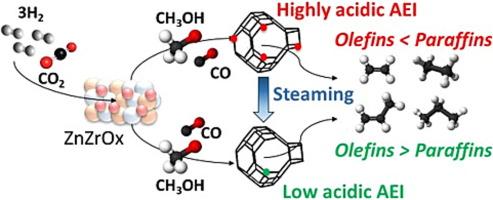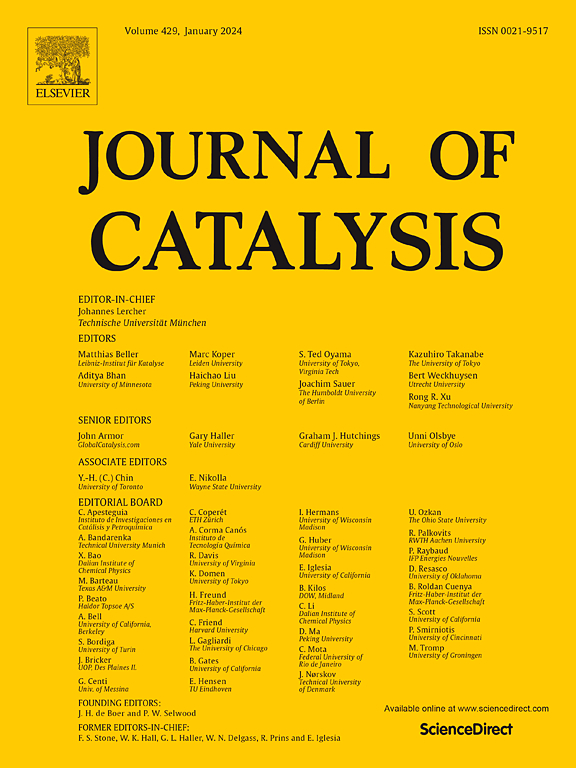Role of coupling and zeolite acidity in the methanol-mediated CO2 conversion to olefins over ZnZrOx-AEI zeolite tandem catalysis
IF 6.5
1区 化学
Q2 CHEMISTRY, PHYSICAL
引用次数: 0
Abstract
The tandem conversion of carbon dioxide to olefins (CTO) via methanol over a combination of metal oxide plus zeolite catalysts is a considerable alternative to fossil-based routes to light olefins. Here, AEI type small pore zeolites i.e., SSZ-39 and SAPO-18, in combination with ZnZrOx, are put forward as the excellent tandem catalysts for CTO. We deconvolute the influences of acidity and framework composition on the product selectivity and productivity of light olefins. Post-synthesis steaming was utilized as a strategy to tune the acidity and structure of the zeolites. SSZ-39 steamed at 750 °C showed the highest olefin/paraffin ratio (O/P = 2.1) as compared to the unsteamed SSZ-39 with an O/P ratio of 0.2. In contrast, SAPO-18 steamed at 650 °C showed a maximum O/P ratio of 2.1, whereas steaming at higher temperatures resulted in decreased activities. Propylene was observed as the major olefin for both SSZ-39 and SAPO-18 in line with the cage-defining ring size of AEI. It was found through FT-IR and NH3-TPD that the increase in the steaming temperature decreases the Brønsted acidity of SSZ-39 which inhibits both the secondary hydrogenation of olefins to paraffins and the methanol-assisted hydrogen transfer reaction. Coupling of CO2 to methanol (CTM) with methanol to olefins (MTO) reaction increased the CO2 conversion and selectivity towards methanol equivalents by suppressing CO production in tandem systems as compared to the sole CTM reaction. The effect of catalyst bed configuration on product selectivity over the best performing catalyst was also studied, and the highest O/P ratio (3.7) was observed for a powder mixed system opposed to dual bed or mixed bed systems.


偶联和沸石酸度在ZnZrOx-AEI沸石串联催化甲醇催化CO2转化为烯烃中的作用
在金属氧化物和沸石催化剂的组合上,甲醇将二氧化碳串联转化为烯烃(CTO)是一种相当不错的替代化石燃料转化为轻烯烃的途径。本文提出了AEI型小孔沸石SSZ-39和SAPO-18与ZnZrOx结合作为CTO的优良串联催化剂。研究了酸度和骨架组成对轻烯烃产物选择性和产率的影响。合成后蒸煮是一种调整沸石酸度和结构的策略。经750 ℃蒸制的SSZ-39的烯烃/石蜡比最高(O/P = 2.1),而未蒸制的SSZ-39的O/P为0.2。相反,在650 °C蒸煮时,SAPO-18的O/P比最大为2.1,而在较高温度蒸煮导致活性降低。SSZ-39和SAPO-18的主要烯烃为丙烯,与AEI的笼形环尺寸一致。通过FT-IR和NH3-TPD分析发现,蒸制温度的升高降低了SSZ-39的Brønsted酸性,抑制了烯烃二次加氢制石蜡和甲醇辅助氢转移反应。与单独的CTM反应相比,CO2到甲醇(CTM)与甲醇制烯烃(MTO)反应的耦合通过抑制串联系统中CO的产生,提高了CO2转化和甲醇当量的选择性。此外,还研究了催化剂床构型对最佳催化剂的产物选择性的影响,并观察到与双床或混合床系统相比,粉末混合系统的O/P比最高(3.7)。
本文章由计算机程序翻译,如有差异,请以英文原文为准。
求助全文
约1分钟内获得全文
求助全文
来源期刊

Journal of Catalysis
工程技术-工程:化工
CiteScore
12.30
自引率
5.50%
发文量
447
审稿时长
31 days
期刊介绍:
The Journal of Catalysis publishes scholarly articles on both heterogeneous and homogeneous catalysis, covering a wide range of chemical transformations. These include various types of catalysis, such as those mediated by photons, plasmons, and electrons. The focus of the studies is to understand the relationship between catalytic function and the underlying chemical properties of surfaces and metal complexes.
The articles in the journal offer innovative concepts and explore the synthesis and kinetics of inorganic solids and homogeneous complexes. Furthermore, they discuss spectroscopic techniques for characterizing catalysts, investigate the interaction of probes and reacting species with catalysts, and employ theoretical methods.
The research presented in the journal should have direct relevance to the field of catalytic processes, addressing either fundamental aspects or applications of catalysis.
 求助内容:
求助内容: 应助结果提醒方式:
应助结果提醒方式:


